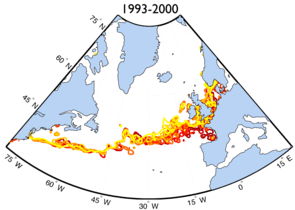North Atlantic Subpolar front shifts
Image of the Month - July 2012
The annual means of the Absolute dynamic topography zero line for two different periods: 1993-2000 (left), 2001-2010 (right). Until the Mid-Atlantic ocean ridge, the Gulf Stream is more or less locked to the bottom topography, hence no change in its location. However after passing this Mid-Atlantic Ridge, large spatial variability can be seen. The larger difference between the two studied periods are along the Eastern boundary. In the first period, the North Atlantic subpolar front reaches a more Southern part of Europe (Bay of Biscaye, Brittany, South of the Bristish islands). During the second period, it reaches the whole of the British islands, Norway...
(courtesy L. Chafik, Stockholm University)
The way that currents' main fronts shift is one of the information brought by multi-year datasets. With now nearly 20 years of altimetry, such shifts begin to emerge and be more and more studied, correlated with other variations, either (or both) in the ocean or the atmosphere.
The North Atlantic is a key area in ocean general circulation with complex ocean-atmosphere interactions. The impact of the North Atlantic Oscillation, in particular, is documented. It seems that it participates to shift the North Atlantic subpolar front position, as last decade shift, correlated with a neutral-negative phase of the North Atlantic Oscillation, shows. Forecasts hint on a possible shift of the front even more to the North, then linking to the Arctic. More continuous observations will be needed to monitor this in the next years, observations which the next altimetry satellites should bring.
See also:
- Image of the Month, January 2005: Current heat
- Applications: Ocean large-scale circulation
- Applications: Climate
Websites on this subject:
- Ocean circulation (Espere project)






